full issue - Association of Biotechnology and Pharmacy
full issue - Association of Biotechnology and Pharmacy
full issue - Association of Biotechnology and Pharmacy
- No tags were found...
Create successful ePaper yourself
Turn your PDF publications into a flip-book with our unique Google optimized e-Paper software.
Current Trends in <strong>Biotechnology</strong> <strong>and</strong> <strong>Pharmacy</strong>Vol. 5 (1) 1054-1059 January 2011. ISSN 0973-8916 (Print), 2230-7303 (Online)1055counteract resistance. For example, Vancomycinwas discovered in the 1950’s <strong>and</strong> did not showany resistance until the mid 1980’s. After whichcertain nosocomial pathogens developedresistance <strong>and</strong> by early 1990’s molecular studiesdemonstrated that this mechanism prevailed inthe soil microorganisms proving that an earlyintervention would have prevented this emergence.A recent study by Knapp et al. (5) expressedconcern that increased antibiotic resistance insoils could have broad consequences to publichealth through potential exposure through water<strong>and</strong> food supplies. Their results suggested thatthere may be a progressively increasing chance<strong>of</strong> encountering organisms in soils collected fromin <strong>and</strong> around Netherl<strong>and</strong>s exhibiting resistanceto antimicrobial therapy. They concluded thatfurther studies need be performed globally so thatthe scope <strong>and</strong> possible ramifications <strong>of</strong> their resultscould be better understood. Considering thesefacts, we performed these studies with Indian soilsto prove this hypothesis <strong>and</strong> generate baselinedata under Indian context on antibiotic resistancein bacteria living in soils collected from differenthabitats.Materials <strong>and</strong> MethodsRaw materials : Different antibiotics likeamoxicillin, ampicillin, cipr<strong>of</strong>loxacin, erythromycin,penicillin G, tetracycline, vancomycin, amikacin,chloramphenicol, gentamicin, gatifloxacin,kanamycin, neomycin, streptomycin,cycloheximide <strong>and</strong> rifamycin, <strong>and</strong> different mediasuch as Muller Hinton Agar were procured fromHiMedia Laboratories Pvt. Ltd., Mumbai, India.Collection <strong>of</strong> soil samples <strong>and</strong> isolation <strong>of</strong>bacteria : Soil samples <strong>of</strong> about one gram werecollected with sterile metal spatulas from a depth<strong>of</strong> 1–5 cm from different habitats in <strong>and</strong> aroundHyderabad, India, like residential garden soil, farmsoil, public park soil, agricultural field soils,composting manure soils <strong>and</strong> soils near factories<strong>and</strong> lakes in sterile collection bottles. The entirecontents <strong>of</strong> each tube were suspended in 50 mlsterile water <strong>and</strong> vortexed on a shaker. Dilutions<strong>of</strong> 1:10 <strong>and</strong> 1:100 were prepared from thesuspensions. Amounts <strong>of</strong> 1 ml from the originalsuspension <strong>and</strong> from each <strong>of</strong> the dilutions werepipetted into sterile Petri dishes containing 15 ml<strong>of</strong> Muller Hinton agar. Fungal growth wasprevented by the addition <strong>of</strong> 30 µg/ml <strong>of</strong>cycloheximide to the medium. The Petri disheswere incubated at 35°C for 18–24 h in anincubator until the colonies were <strong>full</strong>y formed.Pure colonies were obtained after repeated subculturing<strong>and</strong> the pure colonies were maintainedon nutrient agar slants. Preliminarycharacterization <strong>of</strong> the isolates was based oncolony morphology <strong>and</strong> Gram staining.Antibiotic susceptibility testing : Target isolateswere tested for susceptibility to specifiedantibiotics using a st<strong>and</strong>ard agar disc diffusionmethod. Isolated colonies were initially culturedin nutrient broth at 35 ± 2°C for 24 hours <strong>and</strong> thecell density was adjusted to McFarl<strong>and</strong> 0·5turbidity st<strong>and</strong>ard, resulting in a suspensioncontaining 1–2 × 10 8 cfu ml -1 . Within 15 min afteradjusting the turbidity, a sterile swab was dippedinto the adjusted suspension for inoculation <strong>and</strong>then uniformly streaked over the entire surface<strong>of</strong> a Mueller–Hinton agar (MHA) plate <strong>and</strong> thenthe drug-impregnated discs were placed on thesurface <strong>of</strong> these inoculated MHA plates. Testingfor antibiotic susceptibility was performedfollowing the testing <strong>and</strong> quality assurancepractices outlined in the M2-A6 NCCLSDocument (NCCLS, 1997a). The panel includedamoxicillin (Amx), ampicillin (Amp), cipr<strong>of</strong>loxacin(Cip), erythromycin (Ery), penicillin G (Pen),tetracycline (Tet), vancomycin (Van), amikacin(Amk), chloramphenicol (Chl), gentamicin (Gen),gatifloxacin (Gat), kanamycin (Kan), neomycin(Neo), streptomycin (Str) <strong>and</strong> rifamycin (Rif). TheGanesh Kumar et al













